Investigation of the Economic Mechanism of Utilizing Distributed Solar Photovoltaic Systems in Iran
Abstract
Today, the utilization of small-scale solar systems for houses has increased significantly around the globe. The rise of electricity prices due to elevated prices of fossil fuels coupled with the global concerns about the increased emission of greenhouse gases has fueled the increased application of renewable energy systems. However, such policies have been ineffective in particular countries where the electricity prices are kept too low to control social atmosphere and enhance the people’s well-being for political purposes—in this case, solar systems have witnessed no growth as they have rendered not economically justifiable. In this respect, the present research considers Iran as a country with very low electricity prices coupled with very large potentials for utilizing solar energy in the presence of imbalanced electricity supply and demand, with the research objective being an investigation of the required incentive policies to promote the utilization of distributed solar photovoltaic (DSPV) systems in the country. According to the results, it was figured out that, under the current conditions, escalating the price of electricity for houses (even to as high as 10 times the current prices) cannot cover the costs of the equivalent DSPV systems, indicating a need for another cluster of policies. As an option, one may consider buying the generated electricity by the customer (from renewable sources) at a higher price than that at which the electricity is offered to households via the grid (by a margin of 15 folds), which is supposed to provide the required incentive to expand the utilization of DSPV systems.
1. Introduction
Regarding various issues in energy sources and supply, different countries have revised their energy provision policies. For instance, depleting fossil fuel resources may cause serious environmental issues such as pollutant emission and global warming. Recent price augmentation of fossil fuels (e.g., oil price raised from 40 USD/barrel in 2015 to 70 USD/barrel in 2021) has further added to the problems [1]. Moreover, safe and consistent provision of fossil-derived energy may be challenged by diverse factors such as the Russia–Ukraine conflict that affected the gas exports to Europe [2, 3].
The field of renewable energy has been the topic of extensive studies [4]. In contrast to fossil fuels, renewable sources (except for biofuels) are yet to guarantee the consistent provision of energy due to their high dependence on weather and environmental conditions. Uncertainty in the supply of electricity and occasional outages in the system can interrupt social life as well as national economy [5]. This uncertainty, together with the high cost of renewable systems compared to fossil fuels, has posed serious barriers in our path to the development of renewable systems [6].
Being among the top 30 consumers of electricity in the world, Iran generates only about 5% of its electricity from renewable sources. Natural gas is the primary source of energy in the Iranian power plants, not to mention that Iranian houses are also warmed up by natural gas [7]. Each year, the temperature drop in the cold season dramatically increases the gas consumption, interrupting the delivery of gas to power plants which leads to frequent electricity outages. In this regard, the use of renewable sources not only decreases the dependence on fossil fuels but also facilitates the power delivery to remote areas at higher confidence factors (CFs) [8]. Enjoying 2900 h of sunlight at 1800–2200 kWh/m2 per year (above the global average level), Iran has shown promising potential in utilizing photovoltaic (PV) power generation systems. Therefore, the PV systems can well reduce the dependency on fossil fuels [9]. Solar PV facilities can be classified under two major classes, namely, concentrated and distributed PV systems. In a distributed solar PV (DSPV) system, the electricity is consumed where it is generated, thereby eliminating the cost of power transmission [10]. The grid independence of the DSPV systems makes them highly appropriate for the electricity users in remote areas [11].
Numerous studies have discussed the potential of PV systems in on-grid and off-grid modes [12]. However, the mechanism of using these systems and their associated limitations and business models have been only sparsely addressed.
The main subject matter that should be considered in this respect is the electricity prices for houses. Numerous studies have focused on the incentive policies and mechanisms for expanding the utilization of DPSV systems in Germany, the United States, China, and other developed countries [13]. However, in a comparison of the electricity prices for houses in such countries (e.g., 0.09 USD/kWh in China) with those in the developing countries (e.g., 0.003 USD/kWh), one may understand that the developing countries need different incentive policies and mechanisms to capture the very low electricity prices for houses compared to the finished cost of PV-generated electricity before one can go for expanding the DSPV systems in such countries. Figure 1 presents a comparison between the prices of electricity for houses by grid and by DSPV in a couple of countries [14].
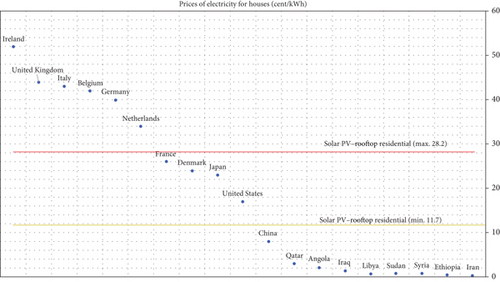
To the best of our knowledge, as far as Iran is concerned, these issues were only discussed by Heirani et al. [15]. They identified the factors affecting the DSPV industry in Iran based on three models: (1) control and ownership by third party or customer, (2) ownership by third party and customer and control by utility, and (3) control and ownership by utility. They also evaluated these three models in terms of coping with the effective factors. Based on the results, the third model could better address the investment problems and political and economic factors. However, its governmental nature and destructive impact on the market competition and the development of such systems make it unsuccessful in the current social conditions. Accordingly, the authors opted for the first model (ownership and control by third party or customer) as the best model for Iran. Moreover, regarding the abrupt fluctuations in exchange rates and the high cost of the PV panels, the guaranteed purchase of electricity at a rate above the selling rate alone cannot sufficiently convince the private companies and customers to consider PV systems. The guaranteed purchase of generated electricity at a price 10 times higher than the selling price of electricity (0.0035 USD/kWh) highlights the necessity of relevant support by nonprofit firms and banks.
Despite the reduction in the cost of solar systems, the use of DSPV systems with storage requires special electricity prices. The amount and model of allocating these electricity prices have been reviewed in many articles [16, 17]. Parra and Patel [18] investigated the battery technology, battery capacity, and electricity price models. The results showed that electricity prices in the form of fixed sales (the price of electricity is fixed throughout the day) are currently the best option for end users in Germany and Switzerland who use battery systems along with solar systems.
On the other hand, expanding the use of DSPV systems without the use of batteries causes problems for the electricity distribution system [19, 20], while reducing the electricity prices to deal with this problem will reduce the expansion of PV systems. Castaneda et al. [21] confirmed this result by studying the long-term effects of electricity price cuts on PV systems in the United Kingdom. They concluded that electricity prices should cause the expansion of storage systems. In order to reduce the effects of PV systems on the grid, Pena-Bello et al. [22] found that the use of dynamic electricity prices (the price of electricity is variable during the day) can reduce the effects of PV on the grid without reducing the expansion of the DSPV systems.
So far, many articles have been published regarding the expansion of DSPV systems [23–25]. In most of developing countries, however, DSPV systems are yet to reach success due to too low electricity prices set by governments [26]. As a result, one may need a different model of pricing for electricity to promote the expansion of DSPV systems while reducing the effects on the grid (i.e., expanding the use of batteries and storage devices) [27, 28], as compared to developed countries.
In similar articles [29, 30] regarding the investigation of the expansion of the use of DSPV systems, due to the small difference between the price of grid electricity and renewable electricity, the focus has been on the investigation of the secondary effects of these systems on the electricity grid. In several articles [31–33], it has been emphasized on the necessity of using batteries to supply electricity during the nonproductive hours of the DSPV system, and the reason for this is to reduce the pressure on the network at the end of the day. But in the countries where the price of electricity is low, the lack of economic justification is the biggest obstacle, and this obstacle cannot be solved with the incentive policies used in developed countries.
A question to answer is that whether or not the current deal of studies on the required changes for promoting the expansion of DSPV systems are applicable to countries where the electricity prices are too low due to political issues or abundance of fossil fuels. In this respect, the present article investigates the required policies and pricing schemes for expanding the utilization of DSPV systems in the developing countries (where the electricity is sold to houses at less than 0.01 USD/kWh). As a case study, we focus on Iran as a country with large potentials for utilizing solar systems coupled with one of the lowest electricity prices for households (i.e., 0.003 USD/kWh).
2. Materials and Methods
As mentioned earlier, in this study, Iran was selected as a country with large potentials for utilizing solar systems coupled with low electricity prices for households. To this end, a single residential house and the required solar system were considered. The proposed methodology used in this paper is presented in Figure 2. The specifications of the selected equipment can be found in Table 1.
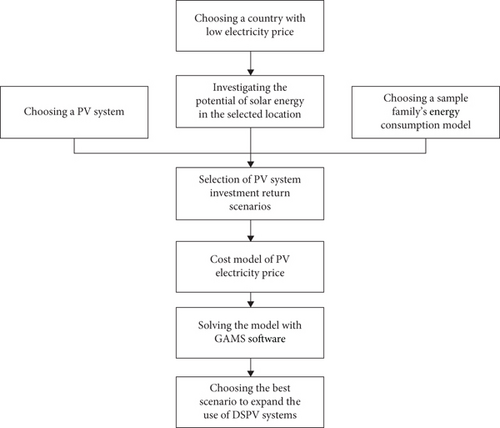
| Equipment | Data |
|---|---|
| Photovoltaic panels | |
| Model | Sharp ND-250QCS |
| Cell type | Polycrystalline silicon |
| Power rating | 250 W |
| Peak efficiency | 15.34% |
| Power tolerances | 0% + 5% |
| Capital cost ($) | 1500/kW |
| Convertor | |
| Capital cost ($) | 300/kWh |
| Battery | |
| Model | 1 kWh Li-ion |
| Capital cost ($) | 400/kWh |
| Throughput | 3000 kWh |
Prices of the PV panel, inverter, and the battery pack include customs fares, applicable taxes, and other relevant costs. In this research, the main objective of the considered DSPV system is to power the house for at least 3 h of outage per day. In order to investigate economic feasibility of this system, three scenarios were considered, including purchase of renewable electricity from the customer at a higher price than that offered to the house via the grid, reducing the price of battery pack for electricity storage, and increasing the price of grid-supplied electricity. Ultimately, annual costs and finished price (per kilowatt-hour) of electricity for the customer were calculated by the general algebraic modeling system (GAMS) software.
2.1. Case Study
This research was conducted in Hossein Abad village near the city of Yazd, Iran. The study area is located in the Central Iranian Plateau, dominated by a hot arid climate. This region is far separated from the country-wide electricity grid, making it a suitable area for this study (Figure 3).
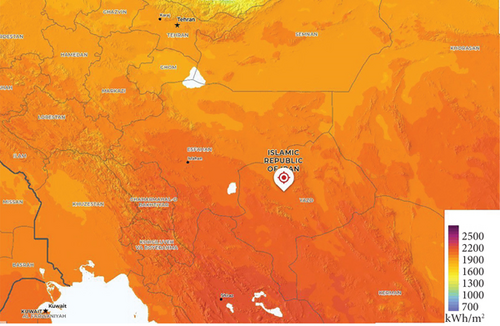
According to the Global Solar Atlas, a 1-kWp solar system can generate 2313.2 kWh/m2 of electricity per year in the study area. Figure 4 shows the average monthly rate of PV-generated electricity in the study area. This figure also presents the average residential consumption load. The temperature elevation of the region in July dramatically increases the power demand. Such a sharp jump of power demand disturbs the power generation capacity all around the country, leading to frequent electricity outages. The average daily consumption of electricity by an Iranian household has been estimated at 8 and 6 kWh in small cities and rural areas, respectively. This includes the lighting, TV, cooking, a small refrigerator, and other applications [34]. The average required power supply for the household in Hossein Abad is shown in Figure 4, considering four individuals in 100-m2 houses.

In recent years, power transmission lines have been developed in most urban and rural areas of Iran. However, numerous outages occur each year due to the population growth, inadequate capacity of power plants, worn out transmission lines, and high cost of power storage technologies. The outages in hot months are mostly due to high demand for energy, while those occurring in cold months are mainly associated with insufficient natural gas supply to power plants. The elimination of the outages requires, inevitably, a balance between the power supply and power demand across the grid. This implies increasing the power generation while lowering the power consumption by the end users. The enhancement of the generation capacity, the use of renewable sources, declining the power loss, and optimal power consumption are among the most common solutions for achieving the mentioned objective. The present article proposes a hybrid solution to alleviate the impacts of power outages by means of batteries and boosting the power generation capacity by renewable sources.
2.2. GAMS Software
GAMS is a high-level modeling system for mathematical optimization and planning. This program is composed of a language compiler coupled with an integrated high-efficiency solver. GAMS is suitable for large-scale complex modeling problems as it allows to build storable large models that can be quickly adapted to new situations. GAMS is particularly designed for modeling linear, nonlinear, and mixed integer optimization problems.
2.3. Economic Optimization
Assuming a maximum power outage of 2 h per day for the case study, the reliability factor (RFCH) of the system [36] in this article was defined based on the ability of the storage system (i.e., battery pack) to supply electricity for 2 h a day. Therefore, the minimum capacity of the battery pack cannot be lower than that required to supply the house demand for two continuous hours.
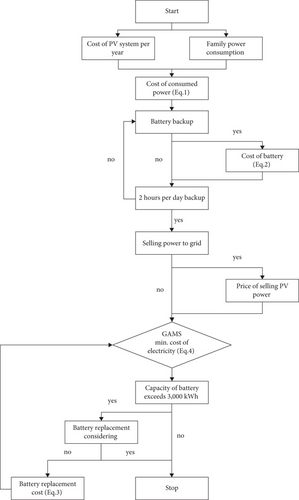
In Equation (4), Z is the objective function that gives total cost of deploying a DSPV system for a full year, including the capital cost of purchasing the PV system, cost of grid-provided electricity minus the income generated from selling the electricity to the grid, cost of the battery pack as a function of its capacity, and the battery replacement cost.
Equations (5) through (16) ensure that a minimum amount of power remains in the battery at all times to maintain the CF in outages.
Equations (17) and (18) imply that a new battery shall be deployed should the required capacity of battery exceeds 3000 kWh.
Equations (19), (20), and (21) set ranges of the decision variables.
The problem was modeled as a mixed integer programing problem. GAMS software was employed to obtain an exact solution to the problem, demonstrating the global optimum of the problem.
3. Results
As mentioned earlier, the only supportive plan to promote DSPV systems is the guaranteed purchase of domestically generated renewable power at a price 10 times higher than the selling rate of electricity to the customer. The model was then solved in the GAMS software considering the difference between the selling and buying prices of electricity. The results highlight the great potential of the region in generating electricity from PV systems, as the generated power can well meet the domestic demands. Solving the model, the values of α and β were obtained for different months of year. Given the high selling price of electricity to the grid (compared to the buying price), it is rational to sell the entire amount of PV-generated power to the grid and then buy the complete electricity demand from the grid. Therefore, except for the required electricity to meet the demand in outages (3 h per day), no power was stored in the battery pack. Based on the modeling results, the annual cost of using a DSPV system capable of supporting 3 h of daily outage in Iran is 1215.145 USD, corresponding to 0.047 USD per kWh of generated power. This latter per-kilowatt-hour cost is too high compared to the offered electricity in Iran. Thus, the current supportive plans for the use of renewable electricity (i.e., guaranteed purchase of generated electricity at a price 10 times higher than the selling price of electricity) is not enough, implying that no DSPV system can be economically efficient under such supportive plans.
For the DSPV systems installed far from the grid, where the entire power demand is supplied by the DSPV system and the battery has sufficient capacity to supply electricity during all times of a full year, the annual cost of electricity reaches 4386.667 USD, which is equivalent to 0.170 USD/kWh. Under the current conditions, this price is not economically justifiable at all, although it is still a practical solution for remote areas where provision of power transmission facilities is costly and difficult.
4. Discussion
The cost of the battery pack is the largest challenge in the proposed system (Table 2). Without a battery pack, the system fails to supply electricity during occasional outages. Accordingly, the utility can lower the prime price of renewable electricity for the customer by supportive battery provision plans (e.g., offering subsided battery prices or selling it via installment plans). At the other end of the spectrum, the required budget for implementing such supportive plans can be furnished by penalizing domestic and industrial high-consumption customers. Therefore, the battery price was considered 10%–40% lower, and the prime price was calculated under two scenarios: (1) equal buying and selling rates of electricity (Figure 6) and (2) the selling price to the grid 10 times higher than the buying rate from the grid (Figure 7).
| The amount of change | Annual cost ($) | DSPV cost (kWh/$) | Costumer cost (kWh/$) |
|---|---|---|---|
| Battery cost reduction | |||
| 0% | 4104.791 | 0.047326 | 0.715245 |
| 10% | 3678.124 | 0.042406 | 0.6409 |
| 20% | 3251.457 | 0.037487 | 0.566555 |
| 30% | 2824.791 | 0.032568 | 0.49221 |
| 40% | 2398.124 | 0.027649 | 0.417864 |
| Battery cost reduction + selling rate to the grid 10 times higher | |||
| 0% | 1215.145 | 0.01401 | 0.211735 |
| 10% | 788.479 | 0.009091 | 0.13739 |
| 20% | 361.812 | 0.004171 | 0.063044 |
| 30% | −64.855 | −0.00075 | −0.0113 |
| 40% | −491.521 | −0.00567 | −0.08565 |
| Selling rate to the grid higher | |||
| 10× | 1215.145 | 0.01401 | 0.211735 |
| 12× | 795.828 | 0.009175 | 0.13867 |
| 14× | 194.198 | 0.002239 | 0.033838 |
| 16× | −407.431 | −0.0047 | −0.07099 |
| 18× | −1009.061 | −0.01163 | −0.17583 |
| 20× | −1610.691 | −0.01857 | −0.28066 |
| Grid EC increase | |||
| 1× | 1215.145 | 0.01401 | 0.211735 |
| 2× | 1234.084 | 0.014228 | 0.215035 |
| 6× | 1309.839 | 0.015102 | 0.228235 |
| 8× | 1347.716 | 0.015538 | 0.234835 |
| 10× | 1385.594 | 0.015975 | 0.241435 |
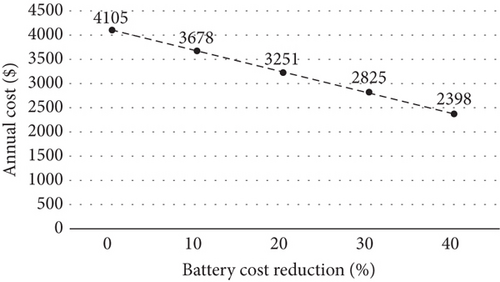
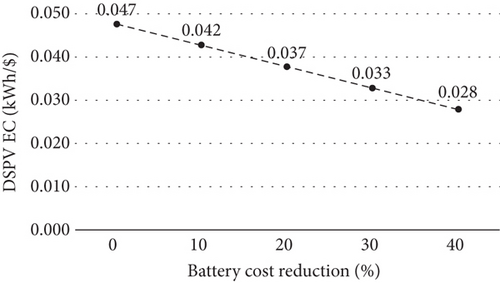
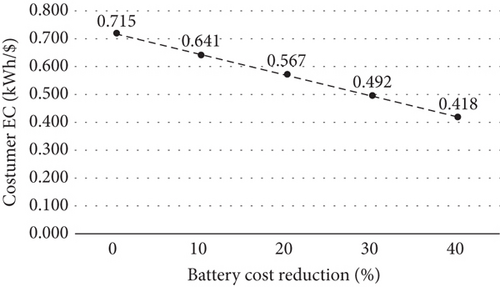
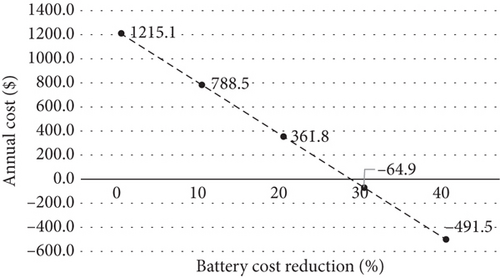

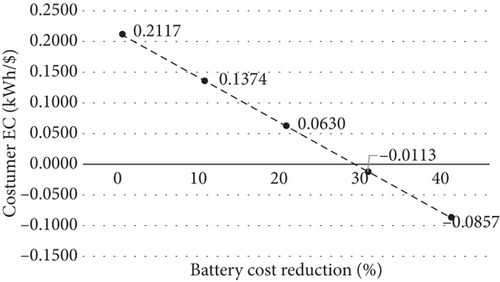
According to Figure 6, in case of equal buying and selling rates of electricity (0.0035 USD/kWh), the entire system was not economically efficient even by considering 40% reduction in the battery price due to the relatively low buying rate of electricity. If the price of battery pack is discounted by as high as 40% (upon eliminating all customs fares and taxes), the finished price of electricity to the customer would be 0.418 USD/kWh, which is even higher than the average global price of electricity. The main reason for this is the too low price of grid-provided electricity (0.0035 USD/kWh) which acts as the major barrier against the growth of the solar industry in Iran.
In contrast, by increasing the selling price of the generated electricity to the grid, a profitable system can be achieved upon 30% discount in the battery cost (Figure 7). The utility can contribute to economic justification and profitability of DSPV system by providing long-term installment plans for battery supply.
Accordingly, under the current set of conditions, the customer of a domestic solar system can raise some profit if the renewable domestically generated electricity is bought by the utility at 0.035 USD/kWh or higher while the battery pack is offered at a discounted price (eliminating the customs fares and taxes).
Therefore, discounting the storage battery prices alone is not enough for promoting the DSPV systems, and one needs to revise the electricity prices as well. As mentioned earlier, due to social-, economic-, and well-being-related issues, balancing the selling price of electricity is not an option in particular countries, in which case the alternative solution is to raise the buying price of renewable electricity.
Sometimes, the utility is not willing to intervene in the battery market and/or offer subsidence mechanism or loans for increasing the customer’s purchasing power for battery. This can be attributed to the disruption of competition in the battery manufacturing industry upon lifting the customs fares and taxes. Assigning subsidies for the battery packs can also lead to larger problems in the future, which has been extensively studied in other articles.
In such cases, rising the buying price of the generated electricity from the customers can be an alternative approach.
Figure 8 demonstrates the outcomes by increasing the buy-to-sell price ratio. Accordingly, under the current condition, a net electricity price of zero can be achieved by raising the buy-to-sell price ratio to 15 (Figure 8). With the help of this policy, customers are encouraged to utilize DSPV systems equipped with battery packs. This brings about two major benefits for the customer: (1) zero payment for the electricity and (2) no power outage. On the other hand, the government can furnish the required budget for implementing such supportive plans by penalizing domestic and industrial high-consumption customers.
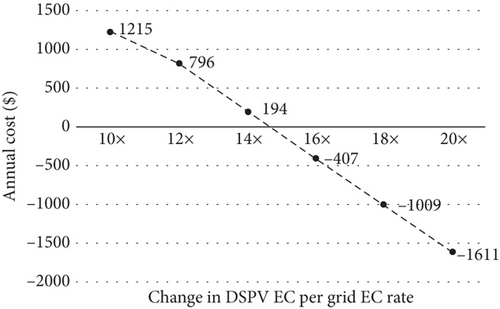
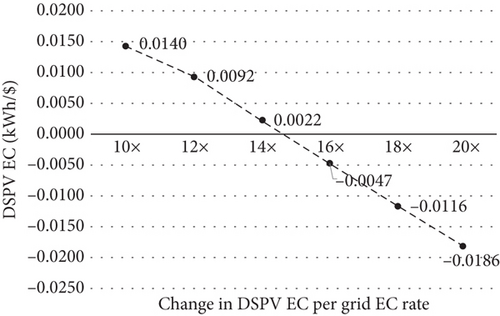
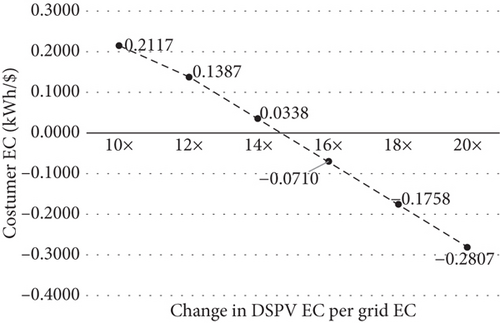
On the other hand, the very low selling price of the electricity to the customers is the largest barrier against any modification to the utility-powered supportive strategies for renewable systems. This has limited the maneuverability of the utility to expand its supportive measures. Based on Figure 9, the prime price of a DSPV system will be increased by 14% by setting the selling and buying rates of electricity to 0.035 USD/kWh (i.e., multiplying the current DSPV electricity prices by 10).
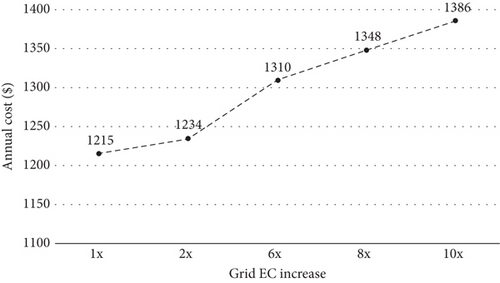
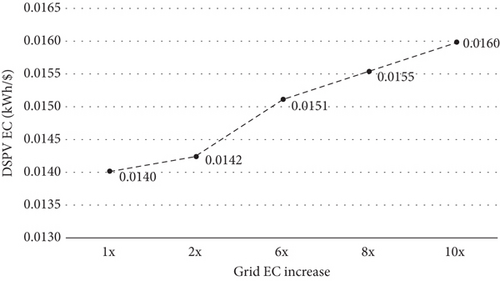
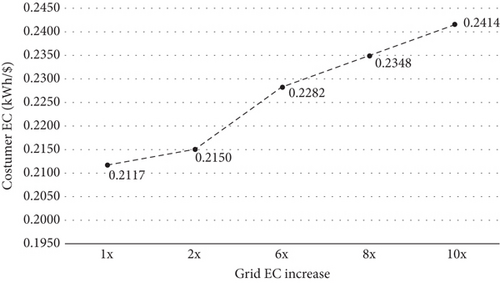
In contrast to the previous case, the increased price of electricity under this scenario cannot lower the price of the DSPV electricity but rather increases it. For the most part, due to the decreased difference between the buying and selling prices of electricity, the customer would raise less income out of selling all generated PV electricity to the grid and then buying the required demand from the grid. Accordingly, a part from the social consequences of increasing the electricity prices, increasing the selling price of domestic electricity may not contribute to the expansion of DSPC systems under the current conditions. Indeed, the electricity prices shall be increased to at least 0.7 USD/kWh (with no supportive plan) before such a scenario can economically justify the utilization of DSPV systems.
Noteworthily, escalating the electricity prices has fueled the utilization of DSPV systems in the world. However, in countries where the electricity prices are set too low and DSPV systems are mainly based on imports (i.e., expensive to general customers), one needs large jumps in the price of domestic electricity before DSPV systems can become economically justifiable. Indeed, the required price escalation is so high that the governments cannot apply for that in practice. In this case, the governments can set the buying rate of renewable electricity and/or discount the cost of DSPV systems by eliminating customs fares and taxes in an attempt to economically justify such systems.
One should further study the effects of such measures in the long run. The proposed policies are required to encourage customers in the developing countries to utilize DSPV systems in the short run. But they may need revisions like localization and reduction of the costs of renewable systems in the long run. Future work may consider dynamic electricity prices to reduce electricity consumption during peak hours and avoid power outages by means of batteries in developing countries.
5. Conclusion
Regarding the necessity of expanding the use of renewable energy systems, the present research is focused on the application of DSPV power generation systems for domestic customers in Iran. Thanks to its large potentials for harvesting solar energy, the city of Yazd is a suitable area for installing DSPV systems. The most important problem that hinders the development of solar energy-based electricity is its high prime price compared to the fossil fuel-based grid electricity. Currently, the Iranian government offers no supportive policy for renewable electricity except for the guaranteed purchase of the electricity from domestic renewable sources at a rate 10 times higher than the price of grid electricity (on average, electricity is sold at 0.0035 USD/kWh in Iran). According to the results, under the current supportive condition, prime price of DSPV electricity is 0.047 and 0.170 USD/kWh in on-grid and off-grid modes, respectively. Regarding such a relatively high prime price of electricity, two supportive strategies are formulated: (1) discounting the price of battery packs for domestic DSPV systems and (2) augmenting the buying price of the renewably generated electricity from customers. For a DSPV system to be profitable to the end user, the utility should provide 30% of the cost of the battery while guaranteeing the purchase of renewable electricity at a price 10 times higher than the current grid electricity prices. If the utility is not willing to provide the cost of the battery, the purchasing price of renewable electricity must be raised to at least 15 times higher than the selling price of the grid electricity. Any of these two supportive policies can result in rational profitability and provide the required incentive to implement domestic DSPV systems in developing countries.
Nomenclature
-
- DSPV
-
- distributed solar photovoltaic
-
- EC
-
- electricity cost
Indexes
-
- i
-
- month index i = 1, 2, ⋯, 12
-
- “∗”
-
- index of the optimal quantity of variables
Parameters
-
- CCH
-
- price of battery per kilowatt-hour of power storage
-
- CPV
-
- price of PV system per 50 m2
-
- CPhotovoltaic
-
- price of PV per 50 m2
-
- CConverter
-
- price of convertor per 50 m2
-
- TCH
-
- useful life of battery in years
-
- TPV
-
- useful life of PV system in years
-
- RCH
-
- battery efficiency
-
- RPV
-
- PV system efficiency
-
- RFCH
-
- reliability factor
-
- SN
-
- selling price of electricity to the grid per kilowatt-hour
-
- CN
-
- buying price of electricity from the grid per kilowatt-hour
-
-
- electricity generation by PV system in ith month in kilowatt-hours per square meter
-
- Ui
-
- monthly electricity consumption in ith month in kilowatt-hours
-
- M
-
- a large value
Decision Variables
-
- αi
-
- percentage of generated power by PV system that is sold to grid in ith month
-
- βi
-
- percentage of consumed power that is purchased from grid in ith month
-
- y
-
- a binary variable that indicates the battery replacement
Conflicts of Interest
The authors declare no conflicts of interest.
Author Contributions
The authors confirm contribution to the paper as follows: study conception and design, Hossein Heirani and Seyedali Sina; data collection, Sana Labbafi and Sina Labbafi; analysis and interpretation of results, Sana Labbafi and Hossein Heirani; and draft manuscript preparation, Sina Labbafi. All authors reviewed the results and approved the final version of the manuscript.
Funding
The authors received no specific funding for this work.
Acknowledgments
The authors have nothing to report.
Open Research
Data Availability Statement
All data are included in the article.




